A 'certain kind of courage' needed: A look at SAF's selection process, training for its bomb disposal experts
Meet the SAF's Explosive Ordnance Disposal team – the unit responsible for getting rid of an unexploded 100kg World War II bomb at an Upper Bukit Timah construction site last month.
SINGAPORE: When the Singapore Armed Forces (SAF) was alerted to a World War II aerial bomb last month, the experts sent to assess the situation had never been involved in such a disposal.
But the team of first-timers, comprising regular servicemen from the SAF’s Explosive Ordnance Disposal (EOD) unit, had been training for this day.
They assessed on Sep 20 that the unexploded bomb was unsafe to be moved from the Upper Bukit Timah construction site. Then, others from the unit – also known as the 36th Battalion of the Singapore Combat Engineers (36SCE) – were roped in to dispose of it on-site.
The unit is the national responder to any explosive incidents and also responds when war relics are discovered.
Full-time national servicemen (NSFs) were among the 45 SAF personnel involved in the disposal operations that spanned six ensuing days. They helped construct the protective works, which included cement blocks and sandbags, to prevent the blast from affecting nearby homes.
One of the NSFs involved told journalists that he wasn’t fazed, despite it being his first time. Third Sergeant (3SG) Teo Jin Kay is serving his National Service as an EOD specialist and has been undergoing training since April. So when the call came to serve, he was ready to answer.
“Once you join, you know you are preparing to be (called up) … Even though you don’t know if you’ll be activated, you’re preparing for the chance that you will be,” the 19-year-old said, matter-of-fact.
“We have to be ready. It’s part of being in 36SCE.”
“CONSISTENTLY LOGICAL”, ABLE TO WORK UNDER STRESS
3SG Teo’s unflappable demeanour is among the traits that EOD unit looks for through its “rigorous selection process” that includes physical and psychometric tests.
“Generally, we’re looking for someone who is logical – consistently logical. We need people who work (well) under stress … and along the way, through their training, demonstrate a certain kind of courage and bravery,” said Lieutenant Colonel (LTC) Ng Tee Yang.
“For example, the team commanders (who) were moving the bomb at Upper Bukit Timah on that day had to be beside the bomb, ready to move it. Knowing the risks that are involved, they still had to do (it).”
While some of these traits can be picked up on psychometric tests, others may require “a bit more time to assess”, the commanding officer in 36SCE said.
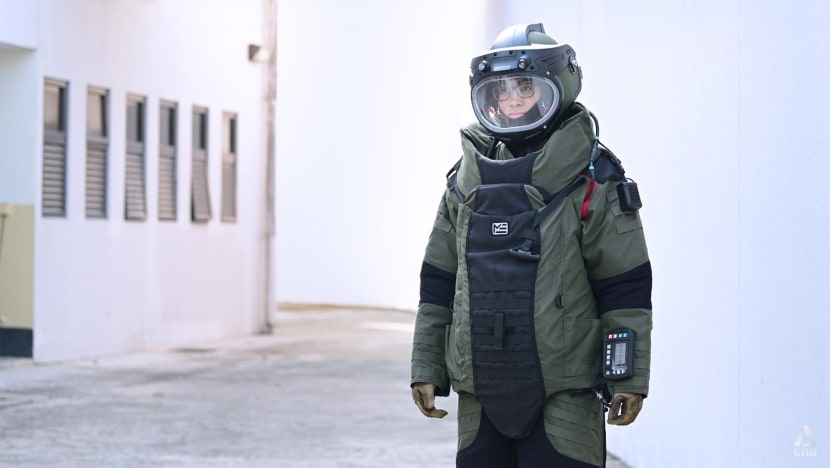
In the physical test, EOD hopefuls are required to don a bomb suit – which some have reported makes them feel claustrophobic as it is “a very closed environment”, said LTC Ng.
They would then need to perform “required skills”, such as being nimble in completing their tasks in an obstacle course.
The bomb suit weighs around 34kg including the helmet, and is typically worn in an improvised explosive device (IED) disposal. It wasn’t used in the Upper Bukit Timah EOD disposal.
The weight of the suit is not the only issue, added First Warrant Officer (1WO) Peter Chong. “As you wear it for a prolonged period of time, the heat build-up in the suit is tremendous. Every time the operator dons the suit, you see the sweat dripping (after five to 10 minutes).”
1WO Chong, a regimental sergeant major in 36SCE, pointed out that the heat “sometimes gets unbearable”. But the men are “trained to withstand it” – often, for hours at a go.
“In our type of operations, you cannot say (you will) only wear half an hour then take a rest. Because (there) is still a threat that is there,” added LTC Ng.
After going through a series of physical challenges, trainees are tasked to complete a puzzle. At the same time, trainers would distract them with questions to assess their ability to multitask and whether they are still “able to perform” and complete the puzzle, he said.
Upon successfully completing the course, NSFs like 3SG Teo take on the role of Third In-Command (3IC), which allows them to be trained in "their fundamental skills and (preparations) beyond peacetime operations”, he added.
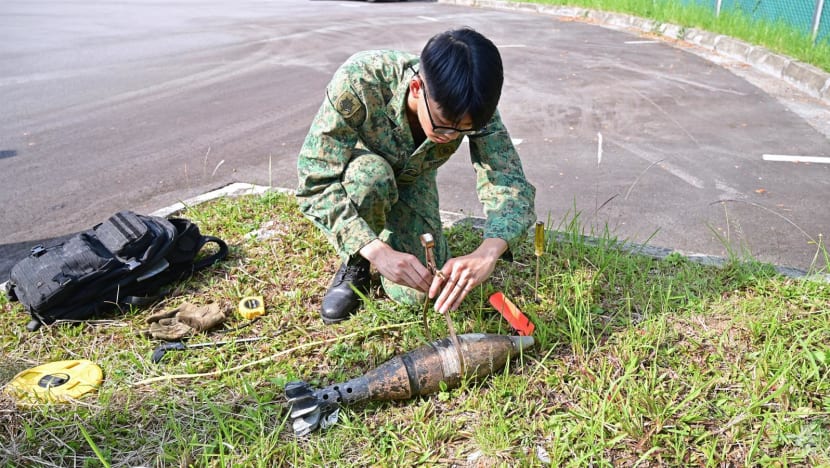
One aspect of EOD training, as demonstrated by 3SG Teo, involves using an Explosive Ordnance Reconnaissance kit to identify an unexploded ordnance.
The kit comes with measuring tools, including a measuring tape and vernier calliper, and other equipment to brush off sand or mud from the ordnance.
Before approaching, however, EOD operators will ask witnesses who discovered the bomb for as many details as possible to eliminate certain hazards before heading in.
Another aspect of training in the unit involves navigating a remotely operated vehicle (ROV) to disrupt an IED. The cameras on the ROV allow operators to manoeuvre the vehicle from a safe distance by assessing the threat via a screen on their end.
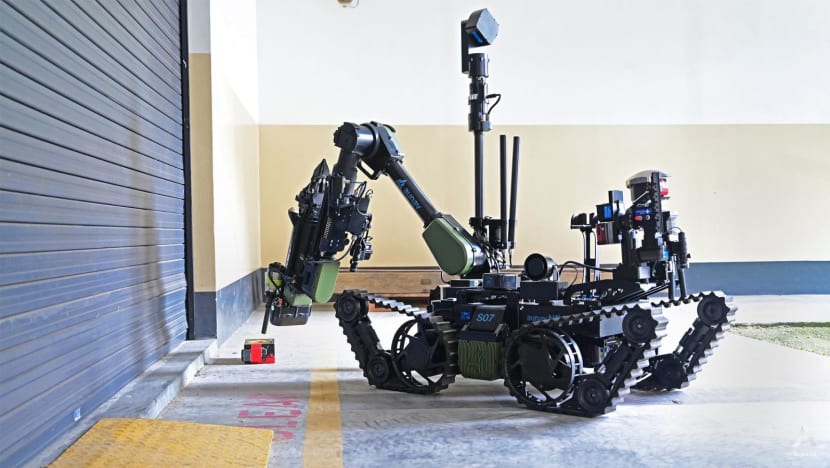
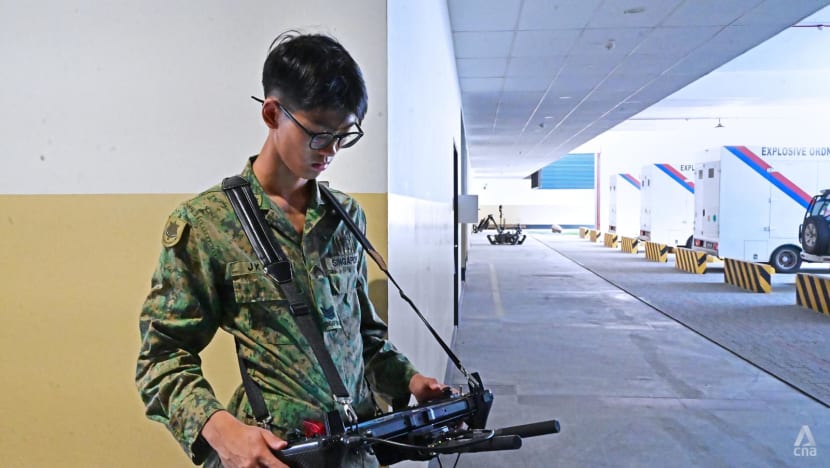
In the Upper Bukit Timah disposal, NSFs made up the team that “supported the plan on ground”, such as by building the protective works, added LTC Ng.
They take “minimally one year to train for both their roles as 3IC in peacetime and their respective roles in hot war (situations)” during NS, and eventually rise up the ranks during their NS cycle.
On the other hand, regulars in the unit will fill the roles of team commander and the Second In-Command (2IC) with “key responsibilities to assess the unexploded ordnance disposal and assess the situation to neutralise any improvised explosive device”, he said.
Such regulars were in the first team sent to assess the Upper Bukit Timah site once the SAF was alerted to the war relic.
When team commanders approach a site, they first look for the fuse of the unexploded ordnance (UXO). This is the firing mechanism or “the brain of the UXO”, and without it, the ordnance is “quite safe”, explained 1WO Chong.
After assessing the possible hazards involved in the ordnance, the team then makes a call: Conduct an on-site disposal or, if it’s safe enough, transport the unexploded bomb elsewhere for disposal.
Regulars take about three to five years to gain experience and go through the necessary training before being assessed to take on the role of team commander, LTC Ng pointed out.
They are selected to undergo a series of assessments to “assess their competency” and “analytical abilities to see if (they) can remain calm and think logically under pressure”.
“Ultimately, we need each operator to make logical and sound decisions to ensure that he and his team move out and come back safely,” he said.
TIGHT COMMUNICATION, TEAMWORK
Rigorous training, significant as it is, must be complemented with teamwork, LTC Ng stressed. The heroic lone ranger singlehandedly detonating an IED that’s often glamorised in Hollywood movies doesn’t happen in reality.
While the Upper Bukit Timah disposal was challenging, it was “not uncommon”, he said, highlighting a similar disposal in 2019.
That year, a 50kg aerial bomb was found in River Valley, also during excavation works at a construction site. It was similarly assessed to be unsafe to move and had to be disposed of on-site.
What made the recent disposal most challenging, however, was its proximity to surrounding residential areas, he said.
As the unexploded war relic had deteriorated after decades, it could trigger an explosion “due to instability”, he added. “We have zero room for errors and we must get it right.”
LTC Ng outlined the “close and tight communication” needed with various agencies to make the mission a success.
The Singapore Police Force managed public safety and communication by helping to evacuate nearby residents, while the Singapore Civil Defence Force was on standby to provide medical assistance for EOD responders and the public.
The Building and Construction Authority was also called in to assess the potential impact on the structural integrity of the surrounding buildings, and SAF worked with the Land Transport Authority to enforce road closures on the day.
SAF also worked with the nearby secondary school to ensure minimal disruption to their examination timetable and the Infocomm Media Development Authority in light of potential telecommunication cables underground.
“It was a complicated operation. But everybody came together with a lot of synergy,” added LTC Ng, noting that the coordination between agencies made the recent operation surprisingly smooth.
The two controlled detonations took place at about 12.30pm and 1.45pm on the day, after which the authorities carried out safety checks in the area until about 5pm. Shortly after, residents were notified through WhatsApp channels set up for their respective estates that safety checks had been completed and they could return home.
Although some Hazel Park residents spotted damage in certain common areas of their condominium, most were relieved to find no damage to their homes.
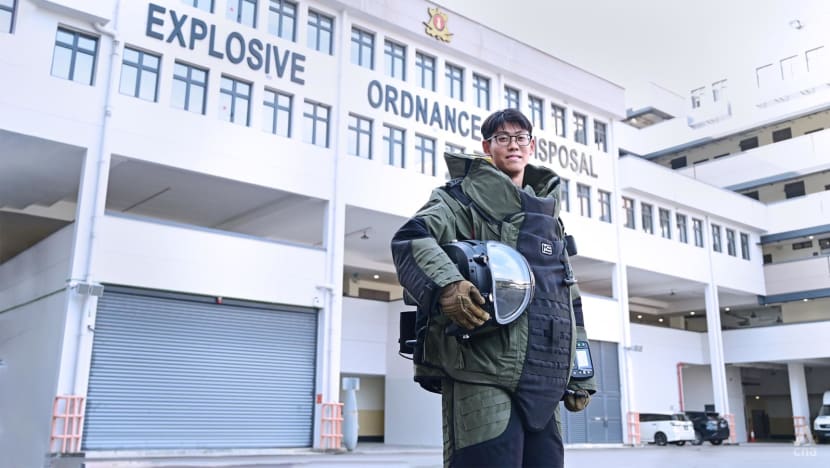
As for 3SG Teo, the Upper Bukit Timah disposal will go down in his books as a “fulfilling experience” – especially since he saw his training “being put into practice” to impact the public, he said.
The 19-year-old NSF had to reassure his parents who were initially concerned when they found out he would be involved in the disposal. But he pointed out that the training “makes sure we perfect all these aspects of an operation, so that in situations like this, we can rely on our training to make sure everything goes smoothly and safely".
In fact, after conducting their assessment at the site, LTC Ng said the team of first responders – which hadn’t attended to such a disposal previously – reflected on how they could “infuse” the experience into their future training.
“The key is to induce stress during training as much as possible … (So that) we go through it during training, such that we don't have to go through it for the first time during a real activation."
Staying abreast with the latest threat landscape and keeping their skills fresh is a necessity, he added.
“The terrorists only need to get it right once, but we need to get it right all the time.”
















